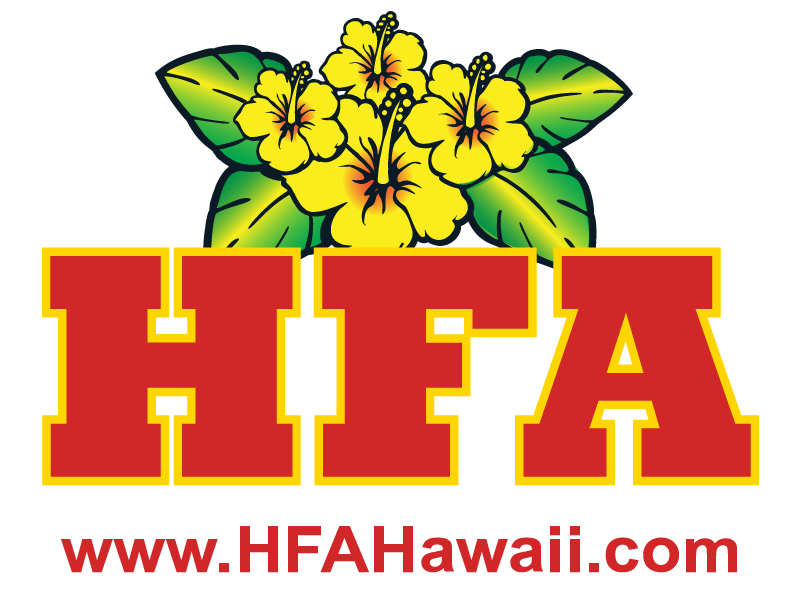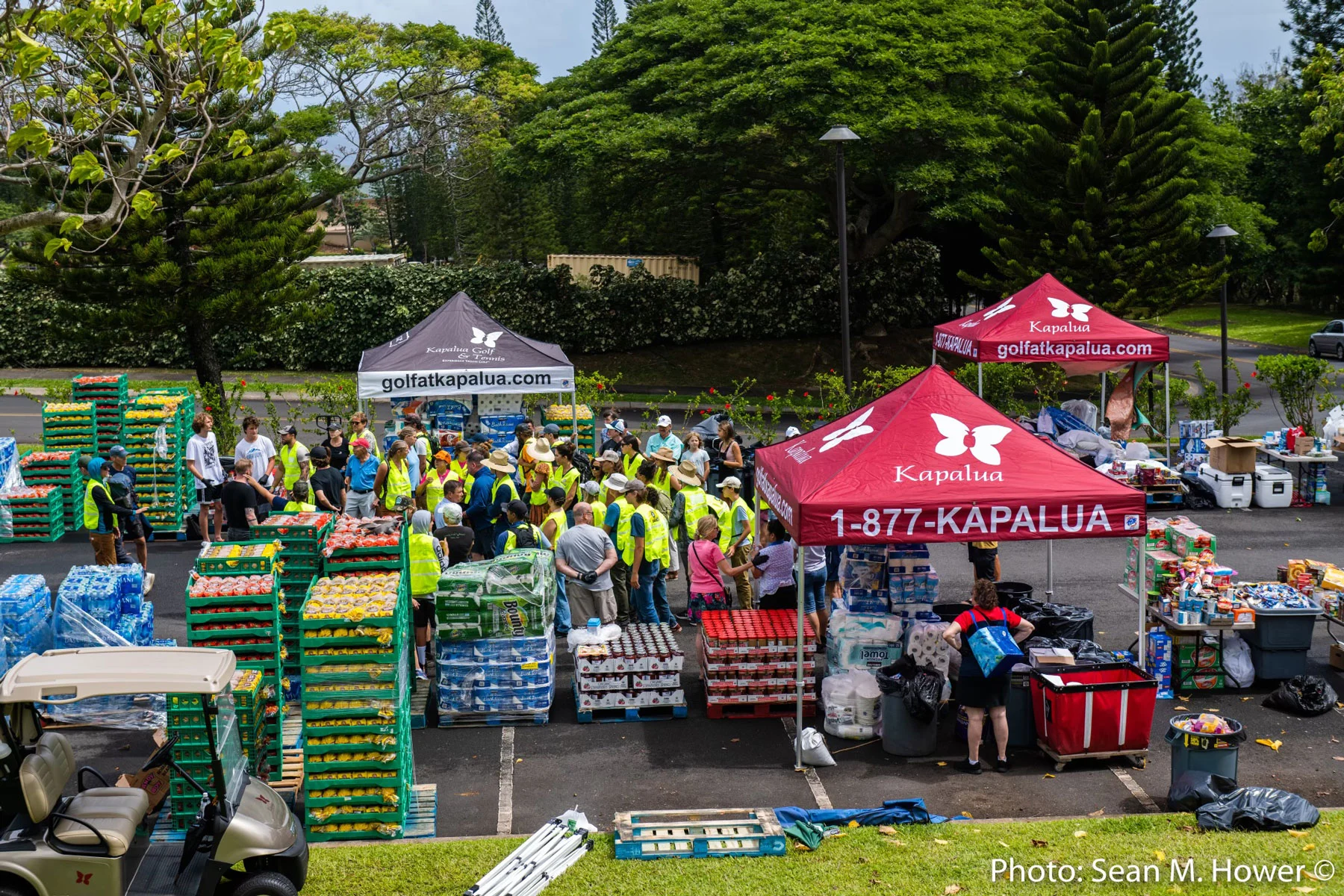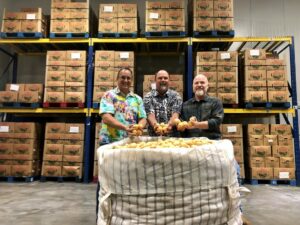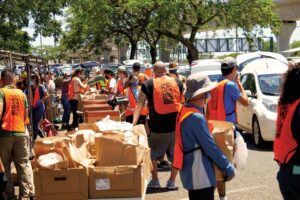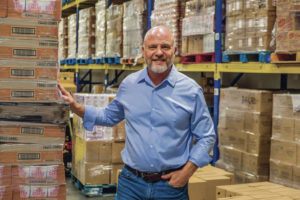Chad Buck, CEO of the Hawaii Foodservice Alliance, was deeply involved with the thousands of other volunteers bringing food and other essentials to the survivors of the wildfires. He describes what he saw and the powerful emotions he and others felt.
Chad Buck says he saw hundreds of families feeding and caring for other families and inviting those survivors into their homes. He saw kūpuna continually embracing and praying for the relief workers. And he worked alongside people who had volunteered after many other disasters and none had ever seen such devastation or so many people in need.
“Each distribution center is managed and cared for by people who have never done this type of thing before and never imagined they ever would be doing this kind of work,” he said.
Buck spoke to me Thursday after returning to the O‘ahu headquarters of the company he runs, Hawaii Foodservice Alliance, after helping supply the needy on Maui from Day One to Day Eight. He said HFA’s team of professionals and fleet of tractor trailers brought their first loads into Lahaina when the West Maui fires were still burning, and have been bringing more ever since.
“We delivered over a million pounds of HFA food, water, and ice along with all of the community donations gathered at War Memorial Stadium. While HFA donated tons of aid to those impacted by the fires, what we gave was a small percentage of what the community provided, family by family, for other families who lost everything. We simply served and connected the givers with those hurting,” he said.
“Families Taking Care of Families.”
He described many Central Maui families housing multiple families – “piled into their living areas, carports and yards. Families taking care of families.”
“The power of kākou by far,” he said, using the Hawaiian word for “us.”
Buck likened the relief efforts to Dunkirk during World War II, when ordinary people – not the Royal Navy – came by the thousands in small boats to rescue exhausted British soldiers trapped on the shore of France and brought them home.
Some people think that government is ready to respond to a natural disaster with food and water supplies. “This just isn’t the case” Buck said.
“Getting much needed supplies to areas in need is reliant on the private sector and volunteers. When it comes to the distribution of food, water and aid across the state of Hawai‘i, the first call that government groups make is to HFA. The morning of the fire, Governor Green called me, asking me to take action immediately to reach as many of those in need as quickly as possible. He told me that that if anyone stood in my way to call his cell as he would immediately break any barrier holding back help. I wasn’t ‘commissioned’ – we were unleashed.”
However, Buck said, government is crucial in coordinating the relief. He and his staff were constantly coordinating with Maui Countyʻs Emergency Operations Center.
“We distribute to all EOC sites, including the drop-off site at War Memorial, where thousands of Maui residents have donated food and other supplies for those impacted by the fires.”
Chad Buck, center right with white beard and hat, and some of the Hawaii Foodservice Alliance team that helped deliver food and other essentials to people in need on Maui. | Photo: courtesy of Chad Buck
He praised the work of all his team members at Hawaii Foodservice Alliance – “from HFA Long Beach and across our island chain, mahalo nui loa to all” – for supporting those in need on Maui.
He also said the community spirit and aloha on Maui are hard to describe. “There is a sense of clarity and purpose that most people have never experienced prior – and probably never will again. Bonds made during these initial days are lifetime bonds,” he said.
“Over time, you understand that everyone processes tragedy and the things that are incomprehensible in their own way. In the initial days, we were talking through tears and struggling to control our breath through the unfathomable grief.”
Chad said one of the early leaders in the relief effort was working so hard he suffered a heart attack and died.
“Absolutely Nothing Compares”
The common initial reaction when entering Lahaina after the fire was disbelief. “You could feel yourself breaking as you drove through the scenes of destruction and tried to comprehend what happened to the families who were unable to escape,” he said.
“Our team members are incredibly strong and tough. We have served after hurricanes on Hawai‘i Island, the floods in Hanalei and at every major food distribution throughout the pandemic. Nothing, absolutely nothing compares to the fires on Maui.”
He said that at first, entry into Lahaina was secured with only a few people allowed to enter. “Our HFA tractor trailer convoys were always escorted by MPD with sirens blaring past the security blocks and traffic waiting at the blockade. Maui Police have been incredibly supportive at every level.”
There are comments on social media that elements of the government were sometimes blocking supplies from reaching people in need. I asked Buck if he saw any evidence of that.
“Absolutely not. There were people doing radical and dangerous things to try to gain entrance to the restricted area,” he said. “Some would have food in their car and raise hell at the blockade and then film themselves with their phone and tell stories like you described. There were a bunch of people that would somehow get past the blockade and then head straight into the restricted areas and homes.”
“We heard heart-breaking stories. Of crews finding the bodies of mothers holding their children clearly trying to shield what was most precious to them. Protecting and respecting those lost were of highest priority; it is hard not to hate those who were violating this sacred place.”
He said stories circulated on Maui that some people were starving or in deep need and the county wasn’t allowing access to them. “I simply didn’t see this anywhere at any time.”
“Distribution centers were established at an incredible pace. Residents were pulling large quantities from the sites if they had a group that they were running product to. I am completely unaware of any site even asking for an ID or question anyone who took whatever they needed or wanted,” he said.
“We didn’t even lock our containers at night. We just figured that if someone took anything, they needed it. Some groups stocked up on product and set up their own smaller distribution sites away from the established sites – unofficial and unimpeded.”
“When people who were outside the disaster area – it was always people from outside the disaster area – told me that they knew of people who were in need or in trouble, I replied that if there were people in trouble, let us know where and we would go there immediately. No one ever had an answer or a place to actually go when asked for specifics. MPD and other teams were everywhere and always on the move. It would have been nearly impossible to NOT connect with someone in need.”
“The Mourning is Unfathomable”
I asked Buck what affected him the most during those initial eight days on Maui.
“The mourning in this community is unfathomable,” he said. “People lost multiple loved ones and all, absolutely all, of their possessions within hours. Working alongside others immersed in dealing with this incredible loss of life and support those suffering, especially in the initial days, felt like a connection to a deeper realm. The early days were frenetic and fueled with adrenaline. Sleep was hard to come by as you tried to process all that happened during the day. Emotions coursed deep and often erupted throughout the day and then woke you at night.”
“I know I share this same deep and spiritual feeling with others who I worked with during the initial days. On day one, I was paired with a Kānaka Maoli working inside the EOC. We were immersed into this tragedy together. We talked and texted about every 10 minutes for the first three days as we exchanged information and formulated the next steps to support wherever was needed, but were never physically together.”
“About Day 4, we found each other at a site in Lahaina, walked into each other’s arms and embraced. We wept and took deep breaths as we embraced. We shared our stories of what happened to us and about lying awake at night and discovered we were having very similar experiences of trying to process.”
“A Mana Wahine told me there is another fire coming in the spiritual realm – maybe what I am experiencing is the inception of this at least for me. In my experience, speaking only for myself, I see and know those mourning and working to heal. I am deeply grateful that I was here in this place and at this time to join hands and hearts as we embraced those giving everything to bring help and healing.”
Sadly, he said, he also saw others outside of this community working to divide.
During an especially trying time in the initial days, Buck said, “My Kanaka Māoli brother told me, ‘There are only three groups of people on Earth. Those hurting, those helping and those hindering. We are fully engaged in helping the hurting so everything else is just noise.’ ”
“My version of this,” Buck said, is that the third category of people – those hindering – are “commissioned from Hell to criticize, self-promote and manufacture drama. The third category inflicts further pain on the hurting by flaming dissension – sometimes pushing the healing process further out of reach from those who need it most.”
